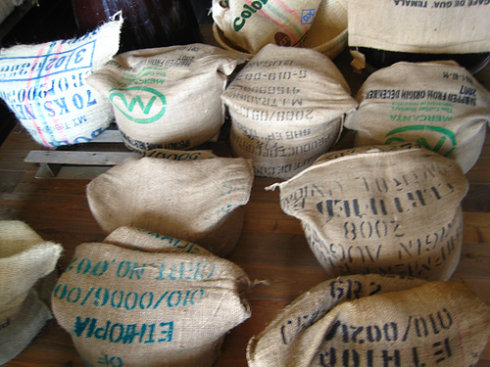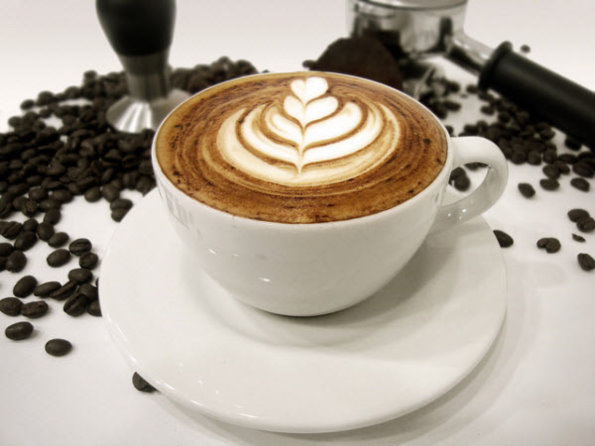The difference between Mandenin Coffee and Golden Manning Coffee in Sumatra Coffee producing area of Indonesia
"Coffee makes you bathe in luxury. Among all the luxuries on the table, coffee is very precious. It inspires happiness but not drunkenness; it stirs up the heart, flows with pleasure, and never comes with sadness, tiredness, or weakness. "
Benjamin ∙ Franklin (1706-1790)
When Benjamin ∙ Franklin wrote this famous quote, he probably thought that two hundred years later, coffee would become the most popular drink in the world.
Left: PWN Manning level 1 right: PWN Gold Manning
Coffee cultivation in Indonesia began at the end of the 17th century and was transplanted from India by the Dutch East India Company to Jakarta, Java. The variety is Arabica Typica, and soon spread to Sumatra in northwest Java and Sulawesi in the northeast. Tippika was withered by a massive rust outbreak in Java in the 1880s, and the Dutch changed to the disease-resistant Robsta. To this day, Robusta is still the main source of Indonesian coffee, accounting for 90% of Indonesian coffee. it is grown all over Java and Bali. The elegant Arabica is mainly distributed in the high-altitude areas of northern Sumatra, Sulawesi and Java, accounting for only about 10% of Indonesia's coffee production. However, Indonesian coffee, such as Mantenin, Golden Manning, Jinding Mantenin, Tawahu, Gayou Mountain, Axie, Sulawesi, aged Mantenin, Java Old Brown, etc., have made Indonesian coffee famous in the boutique coffee world for decades.
Mandailing is neither the name of the Indonesian place name, the name of the producing area, the name of the port, nor the name of the coffee variety, but the mispronunciation of Mandaline, a nation that used to live in Sumatra. During World War II, a Japanese soldier was drinking coffee in Sibolga, central Tapanuli, Indonesia. When he asked the shopkeeper what kind of coffee he was drinking, the boss thought he was from, so he replied "Mandailing". When the Japanese soldier returned home after the war, he remembered that the coffee with a special flavor at that time seemed to be called "Mantenin." in 1968, Nomura Trading Company in Osaka, Japan visited the Indonesian company N. V. Pawani Medan, imported 15000 kilograms of Sumatra mantenin coffee, and was very popular after it was put on the Japanese market. since then, Mantenin Coffee and Pwangni Coffee Company have gained great fame.
Established in 1957, Indonesia's N.V. Pawani Medan (PWN) is the first Indonesian company to export coffee, rubber, cinnamon, cloves and patchouli oil. It is the first Indonesian company to export coffee from North Sumatra and the first company to make "Manning Coffee" famous in Japan. Since 1977, the company has focused on the export of premium coffee beans, Sumatran Arabica coffee Manning I and Robusta coffee AP-I II, mainly to Japan, Taiwan and the United States, of which Japan and Taiwan account for more than 95%. In Japan and Taiwan, "PWN" has become synonymous with "quality assurance". Pwangni Coffee Company holds the "Golden Golden Mandheling" trademark, so Japanese companies have to register the "Jinding Gold Top Mandheling" trademark separately.
Sumatra is the main producing area of Indonesian boutique coffee. The coffee system is complex and can be briefly classified into four types:
(1) Mantenin refers to half-sun or sun-dried beans around Lake Toba in north-central Sumatra and at an altitude of 9-1200 meters above sea level in the Lindong Mountains on the southwest coast.
(2) Gold Manning, after four times of manual screening, is higher than the general Mantenin, and the particles are larger.
(3) Tawahu coffee refers to the washed, semi-washed or sun-dried beans (less) in the area of Gayou Mountain near Tawahu, the northernmost region of Sumatra. The famous Raminita estate in Costa Rica teaches semi-washing technology, and the well-known Dutch coffee group mainly produces Gayou landscape washed beans.
(4) Old Manning and Java Old Brown.
It is customary to call coffee from Sumatra Mantenin, which is neither scientific nor confusing. The coffee produced by the Batak people in Lake Toba or the Lindong Mountains in north-central Sumatra is mostly grown without shade, and is mainly treated by half-sun or sun treatment, with obvious herbal and soil flavor, low acidity and muggy aroma, which is the most important feature of Mantenin coffee, so it is called Mantenin coffee. In the northernmost area of Sumatra, Tawahu or Achelle is planted by another Gaga friend in the traditional shade method, which is mainly washed or semi-washed, with a bright sour flavor and a light fragrance tone. American boutique coffee industry mostly calls this area coffee Axie Coffee, Gayoushan Coffee or Tawahu Coffee.
In short, the general "mantenin" coffee has the unique fragrance of herbs and trees, and the particle size is relatively irregular; the "golden mantenin" coffee of Indonesia's Pwangni coffee company or the "Jinding mantenin" coffee of the Japanese company are mellow and bright. Caramel is more sweet, fruit acidity is more bright and elegant, and there is almost no herbal, earthy and woody taste of Mantenin. Manning coffee is suitable for medium and low roasting, which can reduce miscellaneous flavor, while gold manning has a wider roasting range.
PWN manning first-grade raw bean
PWN manning first-class ripe beans
PWN gold manning raw beans
PWN gold manning ripe beans
Source:
Coffee time blog
Important Notice :
前街咖啡 FrontStreet Coffee has moved to new addredd:
FrontStreet Coffee Address: 315,Donghua East Road,GuangZhou
Tel:020 38364473
- Prev

About the definition of World Fine Coffee specialty coffee knowledge of Coffee
The definition of the concept of boutique coffee specialty coffee (1) the concept of specialty coffee can be traced back to as early as 1974 in the last century, when Ms. Erna Knutsen of the United States first put forward the concept in "tea and coffee trade journal", that is, the Journal of Tea and Coffee Trade, to refer to those who grew up in a special environment with unique aroma and flavor.
- Next

The most important technique of espresso jacquard is to teach you how to make soft foam.
Have you ever had such a cappuccino? It looks like a cup of art and tastes silky? I hope you have, because that's what a cappuccino is all about. If you've ever had a cappuccino like this, I think you'll probably agree with me: it's hard to drink any more bubbly, fluffy cappuccinos. So what makes a real card?
Related
- What is the meaning of lactic acid fermentation with coffee bean treatment?
- How to judge the state of foam by sound?
- How does the latte pull out the unicorn pattern? Come to get for a little trick to improve the flower pull!
- Will flower pulling affect the taste of the latte?
- Do you know the history of coffee?
- The difference between honey treatment and sun washing what is raisin honey treatment?
- What kind of milk can a novice use to make coffee foam to keep the foam longer? The correct method and skills of milking tutorial sharing
- Why do washed coffee beans taste sour? Flavor characteristics of washed Coffee
- Introduction to the skill of how to practice the size and height of water injection around the circle of hand-brewed coffee
- How do beginners practice coffee flower drawing from scratch?

